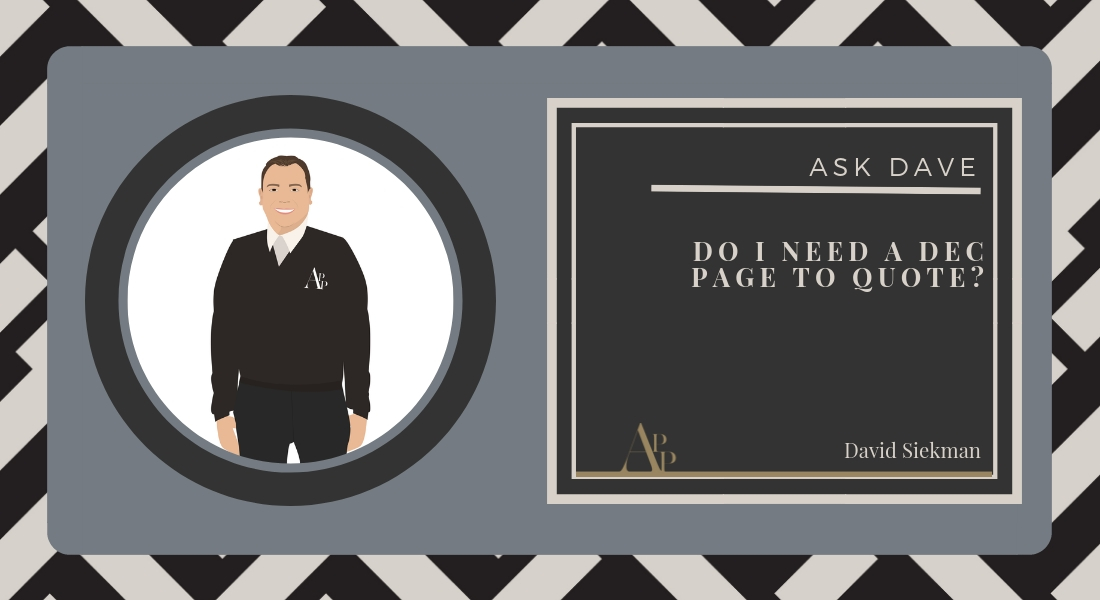I completely understand that having the dec page when putting together a quote has some value. Knowing the existing coverages, limits and premium can all be beneficial when understanding the risk appetite of a consumer as well as helping to set up how you are going to ask for the business. There is also a benefit of having some of the information on the dec page such as VIN numbers or class codes. I’ve even heard that some agents use whether or not the client is willing to send in the dec page as a qualifying factor to determine the level of interest of the client.
I can see some value in most of that. However, the question is not if it helps having the dec page but do the drawbacks to getting the dec page outweigh the value. The biggest drawback is that we are typically asking the client to go well out of their way to make our jobs easy very early on in the relationship. When someone is calling in for help and looking to do business with you, asking them to first do something does not make for a great customer experience. We often talk about the Relationship Bank. This is a bank like any other with deposits and withdrawals. To build a strong relationship and put us in a position to win the business, we want to make more and larger deposits than withdrawals from the prospect. By asking them early on to have to go find a copy of their dec page and figure out how to get it over to us before we are really providing them anything starts us off immediately with a negative balance at the Relationship Bank.
If we assume that the prospect doesn’t have their dec page at their fingertips, we are also immediately preventing ourselves from the opportunity to quote right on the phone. As we have discussed in previous blogs, every time you get off the phone with a prospect, you are reducing your odds of closing the sale. As time goes on and the process becomes less simple, the prospect is more likely to contact other agents or simply decide to stay with the renewal.
The message that we are sending to the client can also be wrong. While I know the term “apples-to-apples comparison” is one that is favored as much as from our clients as ourselves, we are doing ourselves a disservice by creating the impression that what they have for existing limits is going to affect our quote and that premium is the driving factor when we discuss the insurance. I know many agents provide this “apples-to-apples” quote alongside their recommendations. This can provide additional issues as clients will tend to make the decision based on the premium difference instead of the coverage difference. This makes getting them to increase limits or add necessary endorsements difficult.
I realize that at some point we may want or need to obtain a dec page to provide proof of existing coverage or to ensure that we have not missed a coverage, limit, or endorsement that is on the existing policy. All of this can happen after we have provided the quote. Use this opportunity to show your expertise. You are building a policy that is right for them; existing coverages do not indicate whether or not someone has the proper coverage. Show them the value of working with you is more than just copying and pasting their existing coverages. This also allows you to discuss different options without the client simply saying “whatever I have today is fine”. Discussions around deductibles, limits, and endorsements help drive buy-in on the policy that you are building together. You don’t want to pass these up.
Finally, for those that are using obtaining a dec page to qualify “real” prospects, I realize that many times when a prospect is willing to provide a dec page they are showing real interest in working with you. Often these clients have come from a good referral source and have a high close rate. If you are satisfied with your sales and growth and only want to focus your efforts on this set of prospects, I can’t argue with that. However, if you want more sales and want to grow, you need to open up a wider net and recognize that your close rate may take a small hit. Is it better to write 4 out of 5 clients or 7 out of 10? Don’t be afraid to take on a few more opportunities and risk failure because if you aren’t failing, you’re not trying.




